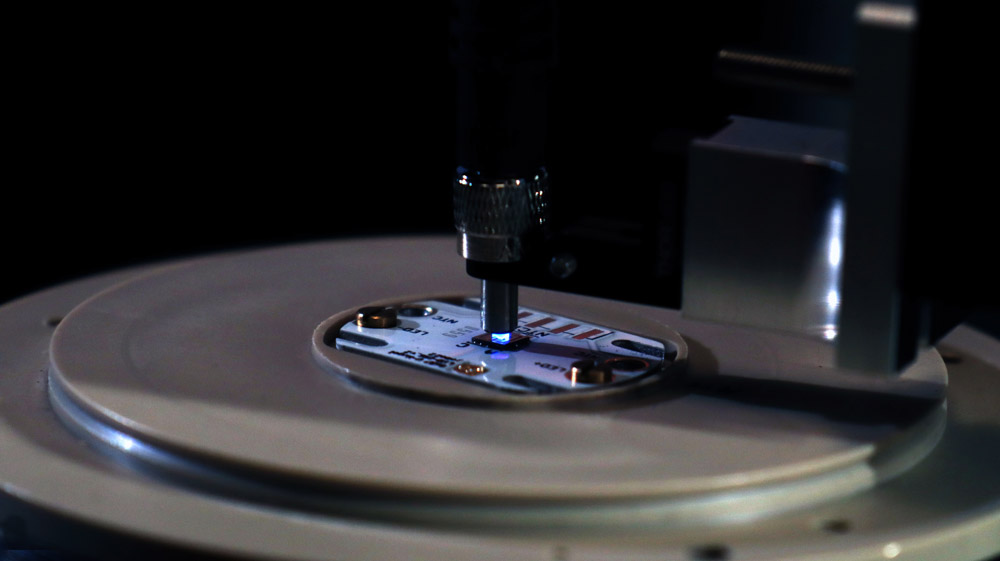News: LEDs
17 July 2025
FBH exceeds 1mW far-UVC LED CW output from single fiber
Multidrug-resistant organisms (MDROs) are a major challenge in everyday medical practice, as they often cannot be treated with antibiotics. According to the Robert Koch Institute, there are 400,000–600,000 hospital-acquired infections in Germany annually, and 10,000–20,000 people die from them. Alternative treatments are therefore needed.
Ferdinand-Braun-Institut, Leibniz-Institut für Höchstfrequenztechnik (FBH) of Berlin, Germany says that its light-emitting diodes (LEDs), which emit light in the far-ultraviolet (UV) spectral range of wavelengths below 235nm, are opening up new opportunities. Due to the high absorption at these wavelengths, the far-UVC is interesting for medical applications, as the light does not penetrate the living layers of the skin and therefore causes less damage than a sunburn. Far-UVC LEDs thus achieve what antibiotics do not always succeed in doing: killing harmful micro-organisms, especially MDROs, without developing resistance.

Picture: Laboratory setup with far-UVC LED chip consisting of tens of thousands of 235nm micro-LEDs emitting into a glass fiber. © FBH/P. Immerz
“With these very short-wave LEDs, we were able to demonstrate international record values in terms of efficiency and performance,” says research group leader Dr Sven Einfeldt, who has many years of experience in the development of UVC LEDs for medical applications. “Together with partners, we now want to take the next step from the laboratory to practical application with a prototype.”
FBH has already developed 233nm UVC LEDs and used them to construct panel irradiation systems that have been applied directly to human skin. Extensive studies conducted within two BMFTR-funded projects at Charité — Universitätsmedizin Berlin and Universitätsmedizin Greifswald — have confirmed the effectiveness of the treatment and that it does not cause any lasting damage to the skin.
Nasopharyngeal irradiation system to combat pathogens where they appear
However, these irradiation systems only reach affected areas on the outer skin. That is why the vision of the medical professionals was more ambitious during the tests. “Small LED irradiation sources with an output power of around 1mW that we can insert directly into the nose or throat would be ideal,” says professor Martina Meinke, head of the Center for Skin Physiology at Charité’s Department of Dermatology, Venereology, and Allergology. “This would allow us to inactivate MDROs in their habitats, which have been difficult to reach until now. After disinfecting the entire body with special washing lotions and mouthwashes, it would be possible, for example, to completely eliminate MRSA bacteria.”
Such a nasopharyngeal endoscope, which reduces germs within clinically relevant time frames, is no longer a distant vision. FBH has further developed its UVC LEDs so that they deliver the required output power. When integrated into an endoscope, the required irradiation times of about 5 minutes could be achieved without significant heat generation.
Record 235nm UVC LEDs for medicine and sensor technology
Due to the aluminium gallium nitride (AlGaN) material system that is used, far-UVC LEDs are technologically demanding and have not yet delivered the performance required for commercial applications. Driven primarily by the work of Dr Jens Rass, FBH has now succeeded for the first time in exceeding the important threshold of 1mW output power with far-UVC light in continuous wave (CW) operation from a single fiber — a record that was recently presented at a conference. This milestone opens up applications in antiseptics and sensor technology.
This was achieved using 235nm UV micro-LEDs arranged in a dense array. This allows five times more light to be coupled into the fiber than with conventional far-UVC LEDs. The micro-LEDs themselves, of which up to 125,000 are arranged on a chip measuring 1mm2, are extremely compact, with diameters of only about 1.5μm. This not only allows more light to be coupled out of the individual chip but also makes it more directional and therefore very precise.
Due to their compact design and high performance, such fiber-coupled light sources would be suitable for eradicating multi-resistant germs and for disinfection in body cavities. The vision of a light source for disinfecting the nasopharyngeal cavity is thus within reach.









